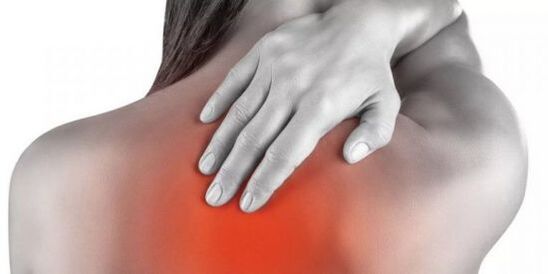
Osteochondrosis is one of the most common pathologies of the spine. It is thought to develop primarily in the neck or lower back. After all, it is in these places that the spine is very mobile and suffers from great stress. But most people's sedentary lifestyle and prolonged sitting at the table led to the fact that osteochondrosis of the thoracic spine began to occur more and more frequently. Although in many cases this condition is not diagnosed immediately. After all, the peculiarity of thoracic osteochondrosis is that its symptoms are nonspecific and resemble many other pathologies.
general features
This degenerative dystrophic disease affects the intervertebral discs of the thoracic spine. This is due to a violation of metabolic processes, leading to thinning and drying of the cartilage tissue. As a result, under the influence of physical exertion, disks begin to collapse and lose their depreciation functions. The vertebrae, ligaments and joints in the spine are gradually affected. Nerve fibers and blood vessels can be damaged.
This process develops slowly, so the pathology is difficult to diagnose. Furthermore, not everyone goes to the doctor immediately because they do not know the danger of thoracic osteochondrosis. But, without treatment, the disease can lead to serious complications. As this part of the spine is responsible for the blood supply and innervation of internal organs, with an advanced form of osteochondrosis of the thoracic spine, various pathologies can develop. Intestinal peristalsis, the functioning of the heart, liver and digestive tract are disturbed. Pancreatitis, cholecystitis, biliary dyskinesia may appear. But most of the time, complications appear in the spine. In addition to intervertebral disc herniation and intercostal neuralgia, spinal cord compression, spondylosis, sciatica, and postural disorders may occur.
Osteochondrosis of the thoracic spine is equally common in men and women. Its appearance is not even age-dependent, although degenerative dystrophic diseases were thought to be characteristic only of the elderly. But modern youth increasingly suffer from osteochondrosis due to poor diet and a sedentary lifestyle.
The most common osteochondrosis is believed to be cervical. Often, the pathology also occurs in the lower back. This is due to the special skeletal structure. In the thoracic region, the spine is less mobile as it is connected with the ribs and sternum.
The intervertebral discs are thinner here and the vertebrae are located closer together. But this section is less susceptible to injury and other external influences, as part of the load is supported by the ribs and chest.
Osteochondrosis usually appears at the level of 7-11 vertebrae. In this case, the intervertebral discs are mainly affected. Most of the time 1-2 segments of the spine are affected. But sometimes polysegmental osteochondrosis develops, in which several discs are destroyed at the same time. Rarely, pathology in this section occurs independently, usually combined with an injury to the cervical or lumbar spine. In this case, the symptoms are more pronounced, facilitating the diagnosis of the disease.
The peculiarity of thoracic osteochondrosis is that it rarely presents with back pain after exertion, as is the case when it is located in the cervical or lumbar spine. Early stage pathology is confused with heart or lung disease. After all, pain is usually localized in the chest, shortness of breath, nausea, chills appear. But the manifestations of thoracic osteochondrosis are not very clear, so patients do not always go to the doctor at an early stage. Because of this, the pathology progresses.

disease development
The danger of thoracic osteochondrosis is that it is "disguised" as other diseases. The pathology develops slowly, rarely do any of the patients go to the doctor at an early stage. Osteochondrosis begins with thinning of the intervertebral disc. Its core flattens, the shell cracks and dries, and the vertebrae get closer together. There is usually no major discomfort at this stage, just slight muscle tension. If the disease can be detected, it can be completely cured by restoring the condition of the discs.
But usually the progression of osteochondrosis continues. In the surrounding soft tissue, an inflammatory process can start, the joint capsules suffer. The mobility of the spine is reduced, the vertebrae can be displaced. If increased physical activity continues, due to the friction of the vertebrae against each other, microcracks will appear in them. At this time, there is a feeling of tightness in the chest, pain with any movement in the upper body.
In the third stage of osteochondrosis, the intervertebral discs become very thin, protrusions and hernias appear. Spine mobility is almost totally limited. Osteophytes begin to form in the vertebrae. This phase is characterized by a pronounced radicular syndrome, as the nerve fibers are damaged. In this case, the functioning of Organs internal organs is seriously impaired. In most cases, this is when the patient goes to the doctor and starts treatment. If this is not done, complications can lead to disability and, when the spinal cord is compressed, to complete immobility.
The last stage of osteochondrosis is characterized by complete destruction of the discs and loss of function. The bone tissue in the vertebrae starts to collapse, so that the mobility of the spine is completely impaired. All vegetative and root symptoms of thoracic osteochondrosis are clearly pronounced.

The development of thoracic osteochondrosis is undulating. It is usually a chronic process that occurs slowly, with little discomfort. There may be increased fatigue, weakness. And when exposed to external factors, an exacerbation with acute pain occurs. In this case, patients are usually hospitalized, as the crisis may be accompanied by a feeling of shortness of breath, difficulty breathing, chest or abdominal pain.
causes
The main cause of thoracic osteochondrosis, as in its other forms, is a violation of mineral metabolism. As a result of degenerative-dystrophic processes, a protrusion or herniated disc appears, it becomes thinner and ceases to perform its functions, the vertebrae gradually collapse, and osteophytes grow. This is most often due to an unbalanced diet, which leads to a lack of essential nutrients or age-related changes in cartilage tissue composition. Disc degeneration can also cause poor circulation in the spine, bad habits, or hereditary predisposition.
But lack of minerals doesn't always lead to osteochondrosis. This requires provocative factors that affect the spine itself.
Therefore, the following reasons for this pathology are also distinguished:
- frequent static loads on the column;
- sitting for a long time in an uncomfortable position at the table;
- lifting weights;
- obesity;
- spinal cord injury or surrounding tissue;
- engaging in strength sports;
- rachiocampsis;
- muscle corset weakness;
- congenital skeletal malformations;
- severe hypothermia;
- nervous overtension.

It turns out that people who spend a lot of time in an uncomfortable position at the table or driving a car, as well as those who perform heavy physical work, are the most susceptible to the development of pathologies. In fact, both the increase in load and its complete absence are equally detrimental to the intervertebral discs.
In addition, osteochondrosis often develops in young people with osteochondropathy. This pathology usually develops in the lower thoracic region in adolescents. It is characterized by necrosis of the spongy tissue of the vertebrae, spinal deformity and the appearance of neurological symptoms. As the pathology progresses, it is complicated by osteochondrosis.
pathology manifestations
The main symptoms of osteochondrosis of the thoracic spine are pain, radicular syndrome and internal organ dysfunction. The pain in this pathology can be acute, paroxysmal or painful, constant, increasing with movement. Sometimes patients are admitted to the hospital with suspected acute pancreatitis, cholecystitis, or urolithiasis. After all, the pain is not always located in the area of the affected vertebrae. Therefore, thoracic osteochondrosis is often confused with pathologies of other organs.
Furthermore, the degenerative processes of the spine in this disease are almost always accompanied by vascular disturbances or intercostal neuralgia. This is due to the special structure of the spine in this section - a small distance between the vertebrae and a large number of nerves and blood vessels.

Thoracic osteochondrosis can be suspected by limiting the mobility of the upper body, increasing the curvature. Intercostal neuralgia frequently occurs. Acute pain can last for several hours or more. It can be triggered by weight lifting, maintaining a static posture for a long time, hypothermia.
If the vessels are affected, there is a violation of the skin's blood supply and nutrition. Because of this, there is an increase in nail fragility, dryness and peeling of the skin. Coldness of the skin and coldness of the limbs are often observed.
Pain characteristics
Pain in osteochondrosis of the thoracic region may differ in intensity and location. Pain usually occurs in the chest or between the shoulder blades. They are aggravated by lifting an arm, turning or bending the body, coughing or sneezing. Pains can be sharp, pressing, painful.
Typically, these sensations are divided into two groups: back and back pain. Dorsago is an attack of sharp pain between the shoulder blades. It is also called "thorax lumbago". The pain is so strong that it prevents the person from moving. A dorsal attack usually occurs after a long stay in a stationary position on the first movement. It is accompanied by muscle spasm so that respiratory function is impaired. The sensation extends to the scapula, between the ribs and into the chest. Chest pain with osteochondrosis resembles an attack of angina pectoris, but instead is not removed by nitroglycerin. Also, the pain increases when pressing on the vertebrae.
Back pain is chronic mild pain. It usually starts gradually, with mild discomfort in the thoracic spine. In this case, the pain can intensify when bending, turning, lifting the arm and even walking. This severely limits the patient's mobility. In addition, an increase in pain may be seen with deep breathing after a long stay in the sitting position or at night. Back pain can last from 2 weeks to a month. The tightness in the chest and shortness of breath may look like pneumonia, but the patient does not have a cough or fever.

root syndrome
When the spasmodic vertebrae or muscles of the nerve roots are compressed, the signs of osteochondrosis in the thoracic region become more pronounced. After all, the spinal nerves located at this location in the spine are responsible for innervating the skin, motor functions of the limbs and functioning of Organs internal organs.
In addition to sharp pain in the back, chest or abdomen, nerve compression is accompanied by the following symptoms:
- paresis or partial paralysis of limbs;
- violation of skin sensitivity;
- numbness, burning, tingling, running "chills" sensation;
- violation of tendon reflexes;
- reflex muscle spasm;
- trophic changes in the skin - hair loss, discoloration, dryness and peeling.
The intensity of these symptoms increases with physical exertion, deep inspiration, prolonged sitting, after hypothermia or stress.

Vegetative Disorders
In the thoracic spine, there are many nerves and blood vessels that ensure the normal functioning of Organs internal organs. Therefore, with osteochondrosis, several autonomic disturbances are necessarily observed. They depend on the location of the affected vertebrae as well as the stage of the pathology.
With spinal injuries in the upper thoracic region, there is discomfort in the esophagus, a feeling of coma in the pharynx. Difficulty in swallowing, voice changes may appear. The middle thoracic vertebrae are responsible for the liver, gallbladder, stomach and pancreas. Therefore, when they are destroyed, symptoms often resemble pancreatitis, cholecystitis, or gastritis. If the degenerative changes affect the lower thoracic vertebrae, there may be problems in the intestines and genitals.
Patients often see a doctor with abdominal pain. They usually get worse at night or after physical work. Furthermore, pain is not associated with the characteristics of the patient's diet. This gastrologic syndrome is characteristic of thoracic osteochondrosis. But despite abdominal pain, bowel disturbance, nausea and flatulence, no problems are found with the functioning of the digestive tract. These sensations arise from damage to the nerves and blood vessels in the spine.
Diagnosis
Because signs of thoracic osteochondrosis are nonspecific, the pathology can only be detected with a thorough examination. At the same time, it is very important to differentiate it from other illnesses. Spinal X-ray or CT scan helps to rule out spondylopathy, rheumatoid arthritis, ankylosing spondylitis.
But other methods of examination are also needed. This is a urinalysis, general and biochemical blood test, fluorography, ECG, MRI or ultrasound of internal organs. This test allows us to exclude pathologies such as pancreatitis, gastritis, stomach ulcers, heart attacks, pneumonia and urolithiasis.

Treatment
The treatment of osteochondrosis of the thoracic spine must be comprehensive. As the cause of the pathology are degenerative processes, it is impossible to completely cure it. Only at the early stage, while the structure of the vertebrae has not yet been disturbed and the discs have only slightly shrunk in size, can this process be stopped and spinal functions restored.
But generally the treatment of thoracic osteochondrosis is aimed at decreasing tissue destruction, alleviating pain and neurological symptoms, and restoring mobility. The choice of therapeutic methods depends on the stage of the pathology, on the location of the degenerative processes, on the manifested symptoms. It is necessary to start treatment as soon as possible so there will be more opportunity to avoid complications.
It's especially important to see a doctor when your back hurts a lot and the sharp pain radiates to your chest or shoulder blade. Such aggravation can be removed with special methods. These are usually medications used in the form of pills or injections, various ointments or compresses, physical therapy procedures. It is also necessary to immobilize the spine: the patient is at bed rest and with restricted movement for several days.
Once the seizure is removed, treatment does not stop. But now its main objective is to stop the degenerative processes and restore tissue trophism. Among the medications for this, cordroprotectors, vitamins and means to improve metabolism are used. In addition, courses in massage and physiotherapy procedures, as well as physiotherapy exercises, are obligatorily prescribed. In addition, the execution of special exercises must be constant. To prevent complications, it is necessary to monitor the diet so that it provides the body with all the necessary vitamins and minerals. Lifestyle is also very important: choosing the right mattress and pillow to sleep in, a chair to work in, alternating rest and physical activity.
Thoracic osteochondrosis is a very serious condition that, if left untreated, can lead to dangerous complications. But difficulties in diagnosis lead to the fact that the disease often progresses. Therefore, it is very important to lead a correct lifestyle and avoid factors that cause disk destruction. This will help prevent the development of osteochondrosis and maintain spinal health.

























